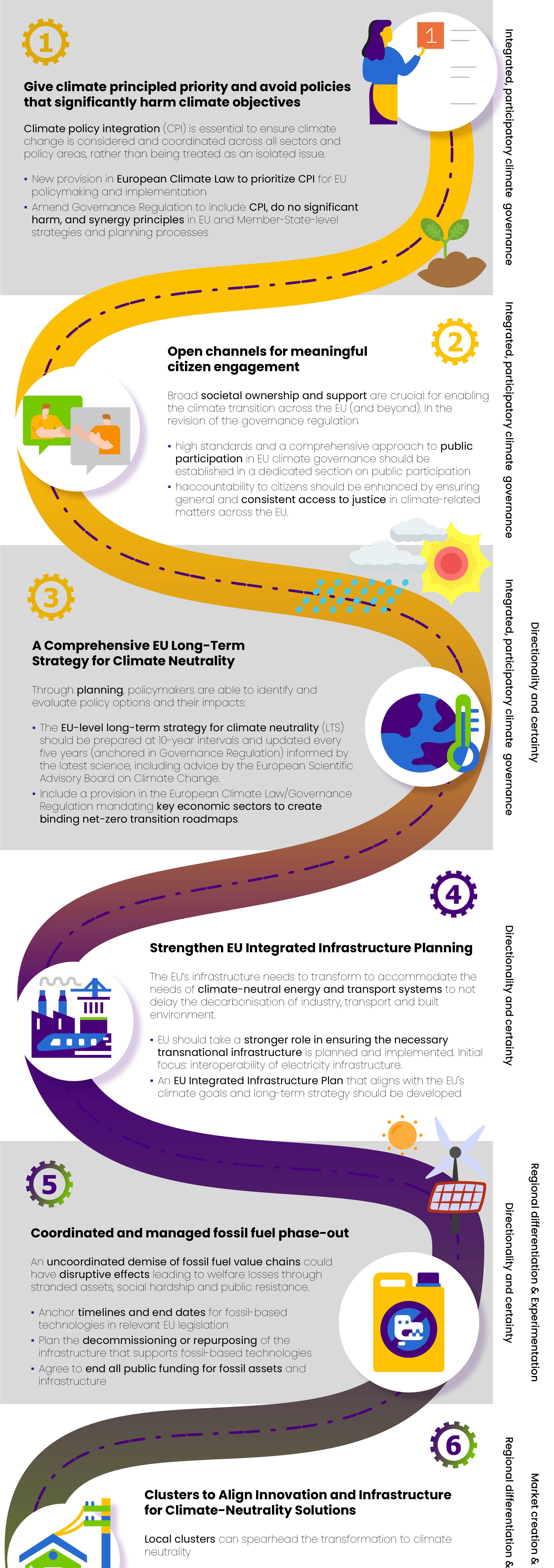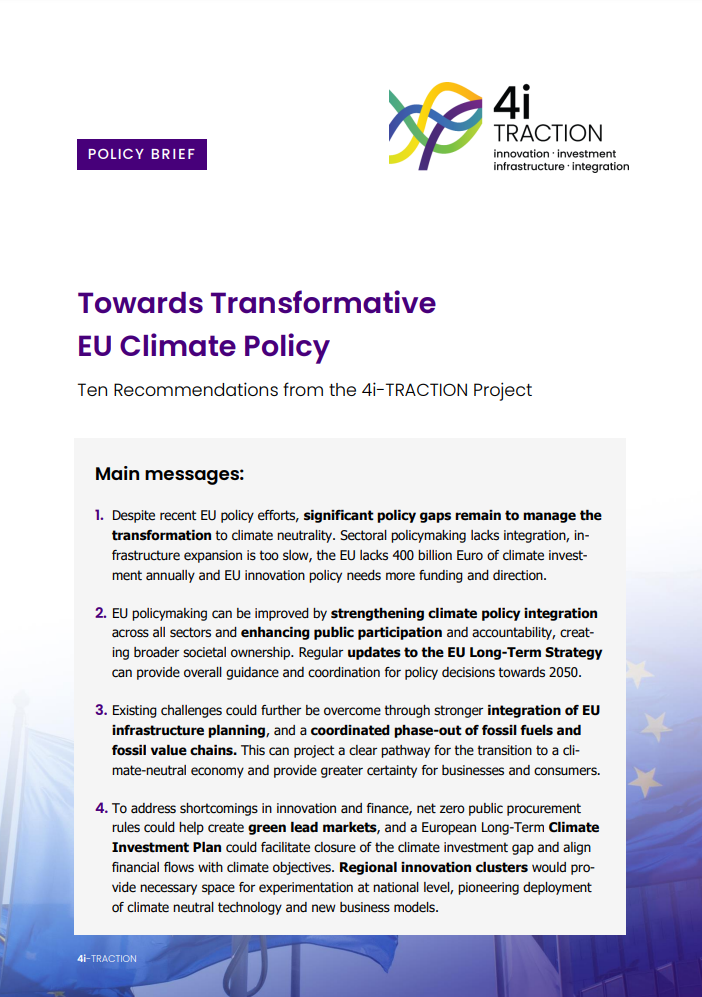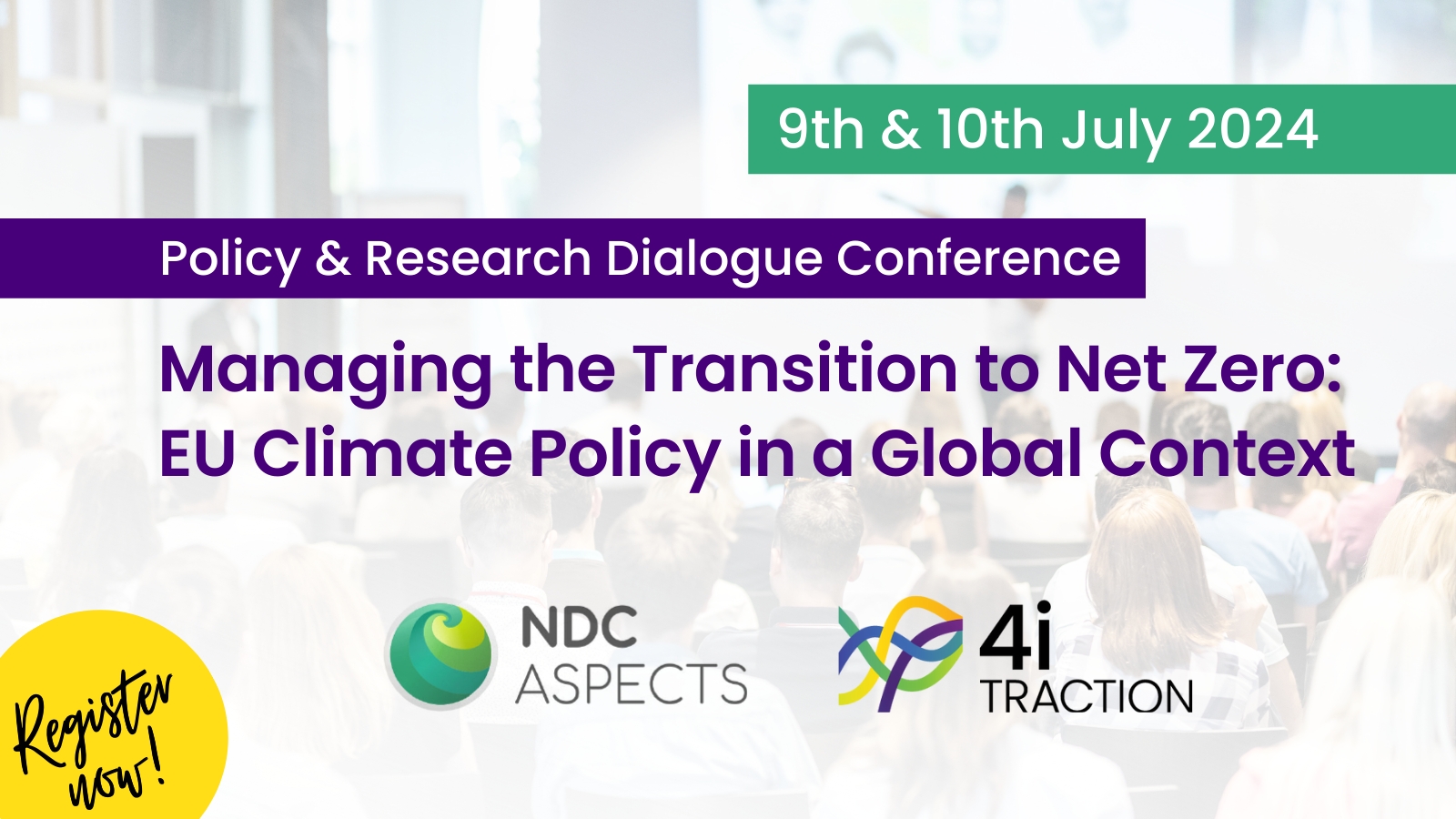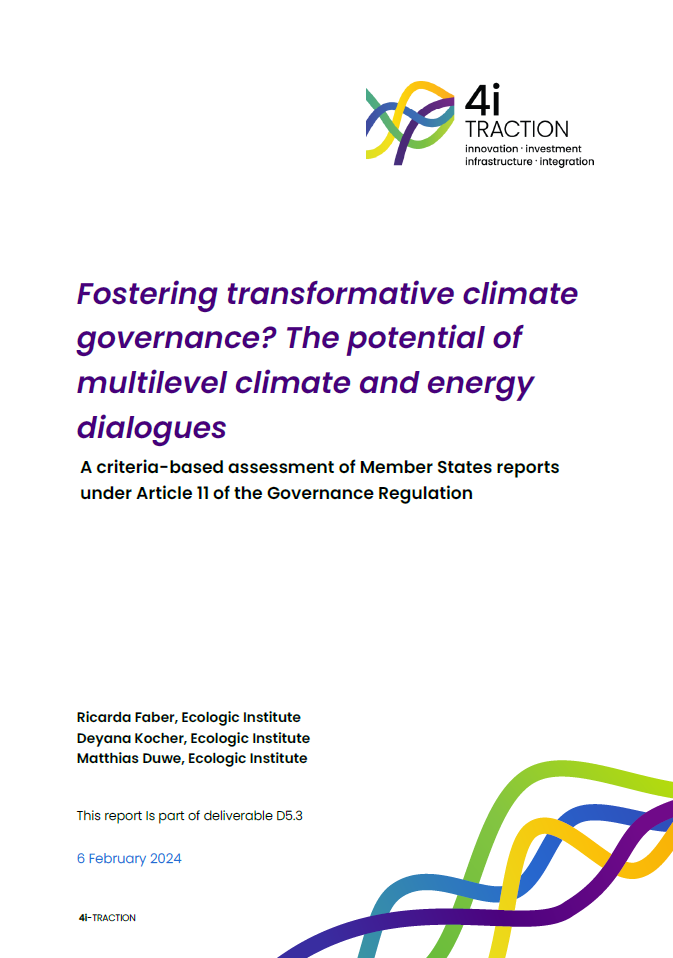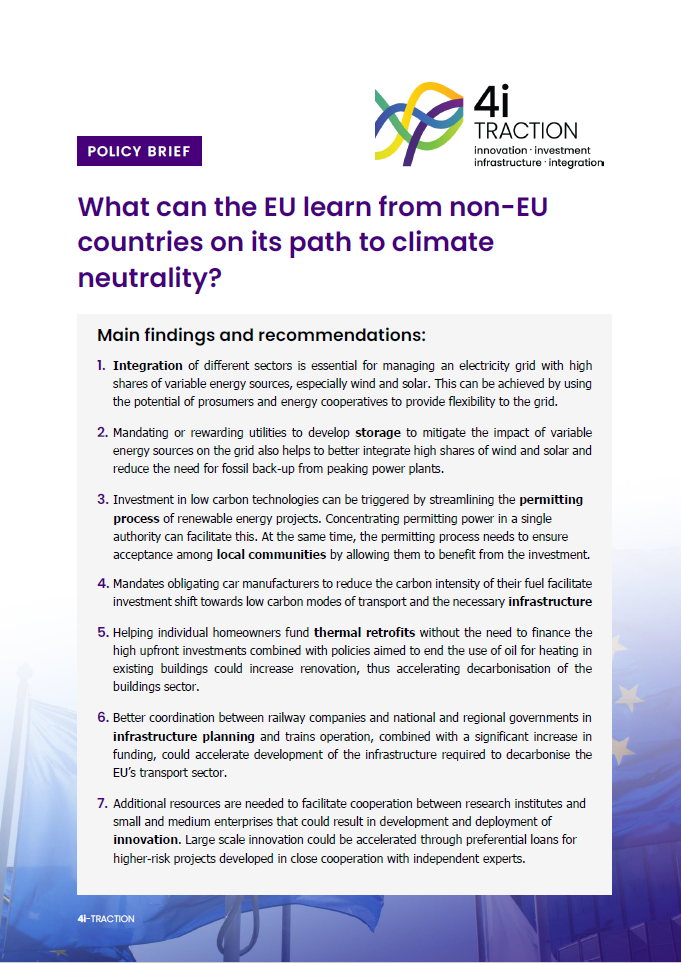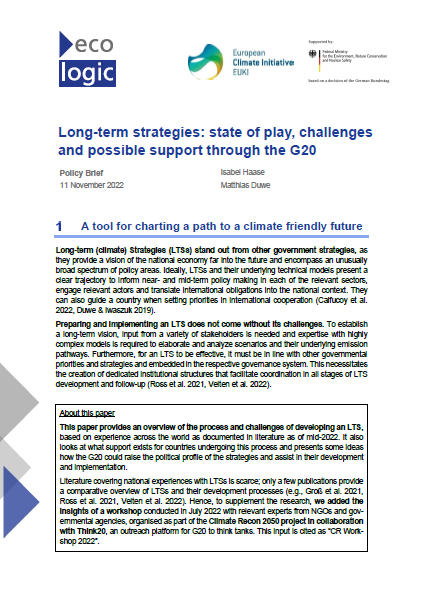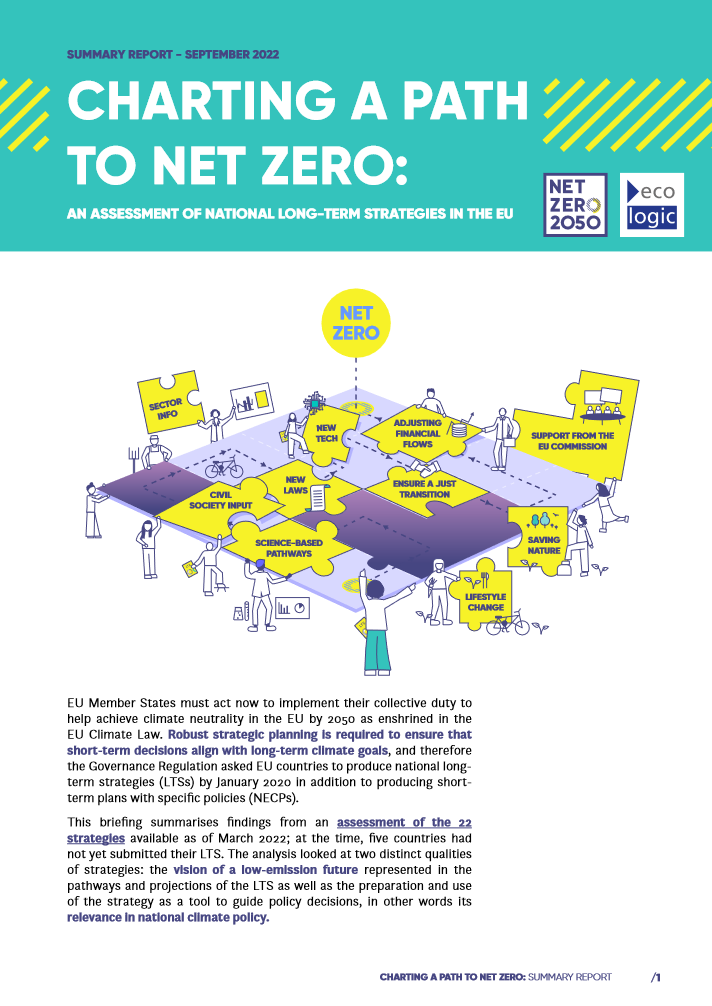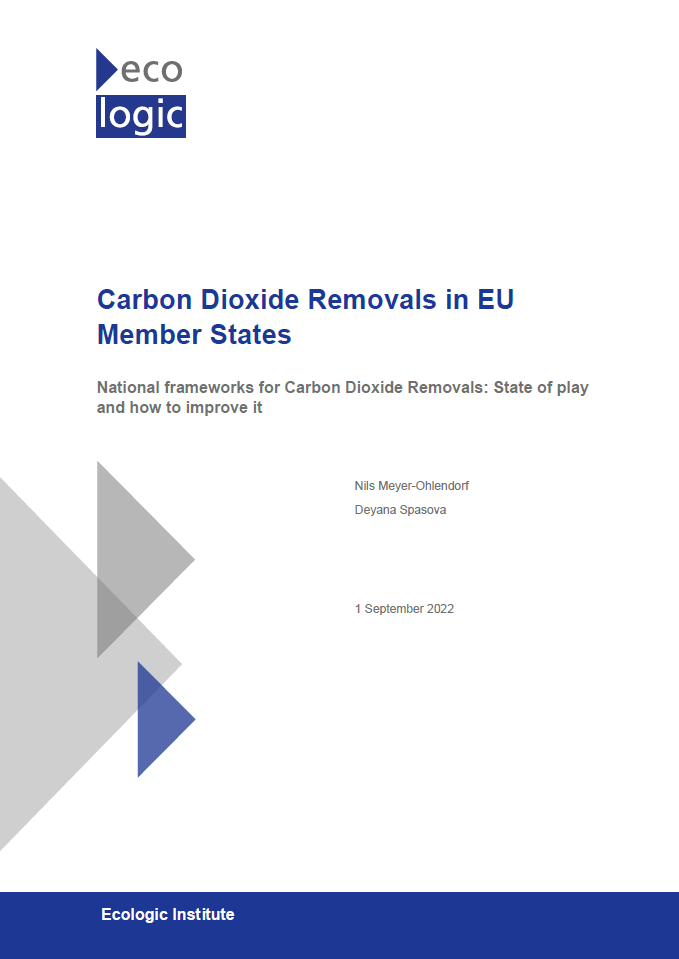What Can the EU Learn from Non-EU Countries on its Path to Climate Neutrality?
- Publikation
- Zitiervorschlag
A Ancygier, D Ramalope, C Waldmann, R Wilson, O Waterton, M Petroni, L Vasilj, E Quill, S Rabiee, M Singh, S Schmidt, W Coleman, L Martini, M Jakob, B Görlach, J Gardiner, A Park, H Hayakawa (2022): What can the EU learn from non-EU countries on its path to climate neutrality? 4i-TRACTION Deliverable D 3.4. Climate Analytics, Ecologic Institute; Berlin
Obwohl sich die EU ehrgeizige Ziele gesetzt hat, gibt es in vielen Bereichen große Umsetzungslücken. Die Untersuchung der erfolgreichen Umsetzung der Klimapolitik in anderen Ländern kann die EU-Politik ergänzen und verbessern und dazu beitragen, diese Umsetzungslücken zu schließen. In dieser Bewertung werden mehrere Fallstudien aus verschiedenen Ländern und Regionen untersucht, die sich auf acht Themenbereiche verteilen: Strommärkte, Innovation, Ausstieg aus fossilen Brennstoffen, Stromspeicherung, Entwicklung des Schienenverkehrs, Personenverkehr auf der Straße und Effizienz in Gebäuden.
Die Fallstudien und Argumente rund um diese Modelle sind entsprechend mit einem der vier Themenbereiche verknüpft: Investitionen, Innovation, Integration und Infrastruktur, die die wichtigsten Herausforderungen darstellen, die die EU auf ihrem Weg zu einem Netto-Null-Emissionsziel bewältigen muss. Die Bewertung zeigt, dass die Vielfalt der Erfahrungen, mit denen die Länder konfrontiert sind, wertvolle Einblicke in die Art und Weise bietet, wie politische Entwicklungen erfolgreich waren und was die EU von ihnen lernen kann.
Ein Policy Brief fasst die Ergebnisse aus 17 Fallstudien von Nicht-EU-Ländern zusammen.
- Sprache
-
Englisch
- Autorenschaft
-
Andrzej Ancygier, Ryan Wilson, Michael Petroni, Olivia Waterton, Celeste Gonzalez, Luka Vasilj, Eoin Quill, Sepideh Rabiee, Mallika Singh, Sylvia Schmidt, Christina Kurre, Walker Coleman, Deborah Ramalope, Clare Waldmann (Climate Analytics)
- Finanzierung
-
Europäische Kommission, Generaldirektion Forschung & Innovation (GD Forschung & Innovation), International - Verlag
-
Climate Analytics GmbH, Deutschland Ecologic Institut, Deutschland - Jahr
- Umfang
- 442 S.
- Projekt
- Projekt-ID
- Inhaltsverzeichnis
-
Gesamtes Inhaltsverzeichnis
Executive Summary
1. Methodological basis
1.1 Introduction and background
1.2 General considerations
1.2.1 Selecting good practices and identifying good practices
1.2.2 The archetypes approach
1.2.3 Conceptual frameworks
1.3 Case study design
1.3.1 Context and background
1.3.2 Description of specific policies and their effects
1.3.3 Lessons for EU
1.4 Synthesising case studies
1.5 Limitations
2. Archetype 1: Decentralisation of the Electricity Sector
2.1 Introduction
2.2 Why consider electricity market design and community batteries?
2.3 Case Study 1: Australia’s Virtual Power Plant (VPP)
2.3.1 Context and background
2.3.2 Policy gap addressed
2.3.3 Description of the policy
2.3.4 Description of policy
2.3.5 Evaluation of policy and its effects
2.3.6 Current and future trends
2.3.7 Discussion
2.4 Case study 2: Community batteries
2.4.1 Context and background
2.4.2 Leading the way: trialling community batteries
2.4.3 Recent updates to the regulatory environment
2.4.4 Political support at the national level
2.4.5 Policy Assessment
2.4.6 Discussion
2.5 Lessons for the European Union
2.5.1 Empowering prosumers
2.5.2 Community energy
2.5.3 Establishing an EU ‘Regulatory Sandbox’ framework
2.6 Conclusion
3. Archetype 2: Innovation
3.1 Introduction
3.2 Why consider an improvement of the European innovation framework
3.3 Case study 1: Department of Energy Loan Program
3.3.1 Context and Background
3.3.2 Energy Loan Program
3.3.3 Policy changes
3.3.4 Policy implementation
3.3.5 Policy evaluation
3.3.6 Discussion
3.4 Case study 2: Small Business Innovation Research programme (SBIR)
3.4.1 Context and Background
3.4.2 Policy Development
3.4.3 The role of the Small Business Administration
3.4.4 Policy Implementation
3.4.5 Policy Evaluation
3.4.6 Discussion
3.5 Case study 3: Small Business Technology Transfer (STTR)
3.5.1 Context and Background
3.5.2 Phases and structure of the STTR programme
3.5.3 The role of the Small Business Administration
3.5.4 Differences between SBIR and STTR programmes
3.5.5 Policy implementation
3.5.6 Policy evaluation
3.5.7 Criticism of STTR
3.5.8 Discussion
3.6 Lessons for the European Union
3.7 Conclusion
4. Archetype 3: Policy driven fossil fuel phase-out in heating and transport (exnovation)
4.1 Introduction
4.1.1 State of decarbonisation in the EU building sector
4.1.2 State of decarbonisation in the EU road transport sector
4.2 Why consider phasing out fossil fuels in Norway and Canada?
4.3 Case Study 1: Phasing out fossil fuels in heating – Norway
4.3.1 Context and background
4.3.2 Ban on the use of oil for heating buildings from 2020
4.3.3 Transition indicators and cost of ownership comparisons
4.3.4 Policy evaluation
4.3.5 Discussion
4.4 Case study 2: Phasing out fossil fuels in heating – Vancouver, Canada
4.4.1 Context and background
4.4.2 Low emission requirements for space heating 2022
4.4.3 Enabling conditions
4.4.4 Discussion
4.5 Case study 3: Norway internal combustion engine vehicle phase-out
4.5.1 Context and background
4.5.2 The 2025 ICEV phase-out target
4.5.3 Policy evaluation
4.5.4 Discussion
4.6 Lessons for the European Union
4.7 Conclusion
5. Archetype 4: Driving storage
5.1 Introduction
5.2 Why consider procurement mandates and Renewable Energy Certificates?
5.3 Case study 1: Storage procurement mandate (California)
5.3.1 Context and background
5.3.2 The early days of California’s storage procurement mandate
5.3.3 Implementation of AB 2514
5.3.4 Updates to the regulatory environment since AB 2514
5.3.5 Evaluating California’s storage procurement mandate
5.3.6 Discussion
5.4 Case study 2: Renewable Energy Certificates (South Korea)
5.4.1 Context and background
5.4.2 Window of opportunity
5.4.3 Policy development
5.4.4 Policy evaluation
5.4.5 Discussion
5.5 Lessons for the European Union
5.6 Conclusions
6. Archetype 5: Railways
6.1 Introduction
6.2 Why consider alternatives to current EU railway policy?
6.3 Case study 1: Railways in Japan
6.3.1 Context and background
6.3.2 Policy development
6.3.3 After privatisation
6.3.4 Funding
6.3.5 Infrastructure development
6.3.6 Policy evaluation
6.3.7 Discussion
6.4 Case study 2: Railways in Switzerland
6.4.1 Context and background
6.4.2 Policy framework
6.4.3 Rail 2000
6.4.4 Infrastructure development
6.4.5 Funding of railways development
6.4.6 Reducing road transport
6.4.7 Decentralisation
6.4.8 European legislation
6.4.9 Policy evaluation
6.4.10 Discussion
6.5 Lessons for the European Union
6.6 Conclusions
7. Archetype 6: Renewables
7.1 Introduction
7.2 Why consider permitting and Renewable Energy Zones?
7.3 Why consider Renewable Energy Zones?
7.4 Case study 1: Wind power permitting in Norway
7.4.1 Context and background
7.4.2 Description of permitting in Norway
7.4.3 Proposed changes to the Norwegian permitting system
7.4.4 Evaluating Norway’s permitting system
7.4.5 Discussion
7.5 Case study 2: Renewable Energy Zones in Australia
7.5.1 Context and background
7.5.2 Development of Renewable Energy Zones in Australia on the national level
7.5.3 Renewable Energy Zones in New South Wales
7.5.4 Challenges for the development of REZs
7.5.5 Discussion
7.6 Lessons for the European Union
7.7 Conclusions
8. Archetype 7: Decarbonisation of passenger cars
8.1 Introduction
8.2 Why consider alternatives to the existing policy framework for passenger cars?
8.3 Case study 1: Low-carbon fuel standard in California
8.3.1 Context and background
8.3.2 Policy framework for the decarbonisation of passenger vehicles
8.3.3 Implementation of the 2007 Low-Carbon Fuel Standard
8.3.4 Subsequent updates to the LCFS
8.3.5 Evaluating the LCFS’s impact
8.3.6 Discussion
8.4 Case study 2: Dual credit policy in China
8.4.1 Context and background
8.4.2 Policy Development
8.4.3 Evaluation of the Dual Credit Policy
8.4.4 Discussion
8.5 Lessons for the European Union
8.6 Conclusions
9. Archetype 8: Decarbonisation of the building sector
9.1 Introduction
9.2 Why consider PACE and the Ithaca Green New Deal as case studies?
9.3 Case study 1: Property Assessed Clean Energy (PACE)
9.3.1 Context and background
9.3.2 The main drivers for the introduction of the PACE scheme
9.3.3 Evaluating PACE programme’s impact
9.3.4 Discussion
9.4 Case study 2: the Ithaca Green New Deal programme
9.4.1 Context and background
9.4.2 Policy development
9.4.3 Evaluating Ithaca’s renovation push
9.4.4 Discussion
9.5 Lessons for the European Union
9.6 Conclusion
10. Conclusions
10.1 Stimulating innovation
10.2 Infrastructure for a resilient, climate-neutral economy
10.3 Shifting investment and finance
10.4 Achieving integration of different sectors
10.5 The EU’s “Man on the Moon” moment
11. Appendix – Other Renewable Energy Zones - Schlüsselwörter
4i-TRACTION (2022): What can the EU learn from non-EU countries on its path to climate neutrality? 4i-TRACTION Policy Brief. Climate Analytics, Berlin.
Haase, Isabel; Duwe, Matthias (2022): Long-term strategies in a G20 context. Ecologic Institute, Berlin.
Velten, Eike Karola, Nick Evans, Deyana Spasova, Matthias Duwe, Ramiro de la Vega, Laurens Duin, and Harrison Branner (2022): Charting a path to net zero: An assessment of national long-term strategies in the EU. Ecologic Institute, Berlin.
Velten, Eike Karola, Duwe, Matthias, Evans, Nick (2022): Charting a path to net zero: An assessment of national long-term strategies in the EU. Summary. Ecologic Institute, Berlin.
Meyer-Ohlendorf, Nils, Deyana Spasova (2022): Carbon Dioxide Removals in EU Member States. Ecologic Institute, Berlin.
Agora Industrie, FutureCamp, Wuppertal Institut und Ecologic Institut (2022): Klimaschutzverträge für die Industrietransformation. Aktualisierte Analyse zur Stahlbranche.
